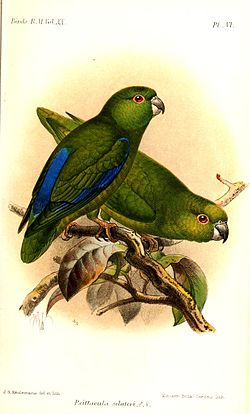| Dusky-billed parrotlet | |
|---|---|
 | |
| At Alta Floresta, Mato Grosso State, Brazil | |
| Scientific classification | |
| Kingdom: | Animalia |
| Phylum: | Chordata |
| Class: | Aves |
| Order: | Psittaciformes |
| Family: | Psittacidae |
| Genus: | Forpus |
| Species: | F. modestus |
| Binomial name | |
| Forpus modestus (Cabanis, 1849) | |
| Subspecies | |
| |
 | |
| Synonyms | |
| |
The dusky-billed parrotlet (Forpus modestus), also known as Sclater's parrotlet, is a small species of parrot in the family Psittacidae. It is the nominate species (F. m. modestus).
Contents
- Subspecies
- Distribution and habitat
- Conservation
- Threats
- Behavior
- Social
- Reproduction
- Diet
- Taxonomy
- Aviculture
- References
- External links
There is one subspecies: Forpus modestus sclateri.


